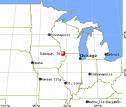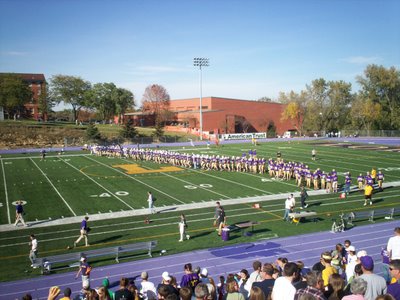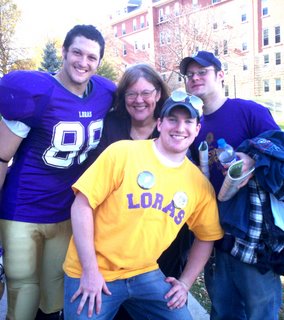What Division III lacks in clout, it more than makes up for in competitive spirit and sportsmanship. You know—those rare things that used to be the raison d’etre of college football in general.
You won’t find many, if any, scandals in Division III. The thuggery quotient is nil. You won’t hear about its players attacking young ladies. Or dealing drugs. Or packing a piece. Or getting under-the-table money.
The young men who play Division III do it because they love to play football while they’re studying at small institutions that are interested in producing individuals who are destined to be productive members of society whether they continue in sports or not. But that doesn’t mean the games aren’t important, or that the kids don’t really care—or don’t give it 100% when they take the field.
 I know all this because I just spent Homecoming Weekend in Dubuque, Iowa, watching the showdown between the host Loras College Duhawks and the Cornell College Rams, both members of the Division III Iowa Intercollegiate Athletic Conference. My interest was journalistic to be sure, but moreso specifically very personal: My son, Leo Brady (left), is the starting tight end and co-captain of the Loras squad, which entered the game on a two-game winning streak after last week’s upset 32-30 victory over conference power Coe College.
I know all this because I just spent Homecoming Weekend in Dubuque, Iowa, watching the showdown between the host Loras College Duhawks and the Cornell College Rams, both members of the Division III Iowa Intercollegiate Athletic Conference. My interest was journalistic to be sure, but moreso specifically very personal: My son, Leo Brady (left), is the starting tight end and co-captain of the Loras squad, which entered the game on a two-game winning streak after last week’s upset 32-30 victory over conference power Coe College. Watching the game, of course, was pure pleasure. Getting to Dubuque from Nashville was quite another story.
It’s a 600-mile trip by car. (621.2 to be precise, according to Yahoo, whose directions I used to get there.) It’s an estimated 10-to-11-hour sojourn. This is true if a) you average about 60 miles per hour; b) you stop only for gas and snack while you drive; c) you don’t get lost; d) there’s no construction; and e) the traffic cooperates. Those seemed like a lot of factors to have to fall into place, and, even at that, the prospect of 10+ hours in a car, without anyone to share the driving, still seemed pretty daunting. But I’d never seen my son play a college game, and I was determined to make the trek.
I learned that you can fly in to Dubuque’s regional airport—if you can get a flight there, available only out of O’Hare Airport in Chicago. Going through all that seemed pointless; besides, I‘d need a car when I got there anyway. So, at 8:20 a.m. on Friday, Oct. 6, I left Nashville in a rental car, jumped on I-24 West, and began the first leg of the long trip.
 I-24 ambles out through Tennessee’s northwest corner, cuts across Kentucky’s southwest corner,and continues in a northwesterly direction up into Illinois. It’s generally pretty country, and even the southern portion of flat and boring Illinois has its bucolic charm. Luckily, all the colors of autumn were springing forth, and the roadways had been recently mowed, making for a neat and picturesque heartland journey.
I-24 ambles out through Tennessee’s northwest corner, cuts across Kentucky’s southwest corner,and continues in a northwesterly direction up into Illinois. It’s generally pretty country, and even the southern portion of flat and boring Illinois has its bucolic charm. Luckily, all the colors of autumn were springing forth, and the roadways had been recently mowed, making for a neat and picturesque heartland journey. 175 miles later, you catch I-57 just south of Champaign, Illinois. 190 miles after that you catch I-74, which eats up 165 more miles heading toward Peoria. By this time, you’ve crossed the Cumberland River, the Tennessee River, the Ohio River, the Illinois River, and even the Spoon River (of Anthology fame). You’ve also wandered into historical terrain, passing through Eureka College, President Reagan’s alma mater, and Galesburg, birthplace of Carl Sandburg and site of one of the more famous Lincoln-Douglas debates. Eventually, I-74 works its way into a 20-mile stretch of I-80 notable mostly for its exits that lead to the Quad Cities of Bettendorf and Davenport, Iowa, and Rock Island and Moline, Illinois, each of which flanks the Mississippi River.
I kept a close watch on the clock in my car. More importantly, I decided early on that I would not allow the posted 65 MPH speed limit to impede my ability to challenge the estimated driving time. It was a gorgeous fall day, sunny and warm, and the traffic was mercifully light. I had encountered a little construction in Paducah, Kentucky, which slowed things to a crawl for a little while, but that was the only glitch.
In short, I drove like a bat out of hell. I hit 80 MPH as often as possible. Sometimes I went 85. Sometimes when I passed cars on the left, I went 90. I pulled back to the 70-75 range on many occasions, but mostly they were the calming respites before gunning it back to 80, passing passels of cars, then pulling quickly over to the right lane to continue on, keeping my eyes on the rearview mirror for police. (Admittedly, at those speeds, I was tempting fate, especially since the state police sometimes use newer-style, deceptively plain compact cars to do their dirty work, and you couldn’t realistically expect to spot one of those in your rearview mirror anyway. Still, I kept ever vigilant.)
My frenzied, pedal-to-the-metal approach paid off big-time. At 4:10 p.m., I crossed the mighty Mississippi on I-80, driving alongside a car full of young men, who I guessed were bound for Iowa City, where the University of Iowa was squaring off against Purdue University the next afternoon in a Big Ten football game. A few minutes later, I turned off onto Iowa Route 61, and headed north 65 more miles. I went 80 MPH on that road as well, a four-lane rural highway surrounded by acres and acres of endless farmland.
At 5:10 p.m., I pulled into Dubuque. I had made the journey in 8 hours and 50 minutes. All I could think was, “Hurray for good roads and good weather and light traffic and for my own moxie and ‘Why the heck don’t we have an Autobahn like the Germans? Why should what I did have been considered illegal when I had so much ground to cover for such an important reason?’ “
 Dubuque, Iowa, is an interesting town. Its population is about 60,000. It’s an old city built upon hills that overlook the Mississippi River. The ethnic makeup historically is predominately German and Irish with other Eastern European strains thrown in for good measure. The homes are sometimes brick, but most seem to be classic midwestern frame houses, some very large, with big front porches.
Dubuque, Iowa, is an interesting town. Its population is about 60,000. It’s an old city built upon hills that overlook the Mississippi River. The ethnic makeup historically is predominately German and Irish with other Eastern European strains thrown in for good measure. The homes are sometimes brick, but most seem to be classic midwestern frame houses, some very large, with big front porches. Looking at Dubuque at a glance, one thinks of fictional settings such as Bedford Falls in It’s a Wonderful Life or the trick-or-treating scene from Meet Me in St. Louis. It looks blessedly average and wholesome, the kind of place where people work, drink and pro-create, and probably in that order. Dubuque looks like it’s seen better days, too, way back when it was a thriving Mississippi port city. Its downtown looks like it’s trying to make a comeback—spurred on by the more recent addition of casino boats at its harbor—but otherwise it also looks a bit haunted by its founder, Julien Dubuque, and the other ghosts of a bygone age, when fur traders or French missionaries were setting up shop. (For the historical lowdown on Dubuque, go here.)
There is something melancholy about Dubuque—it does not look modern, its hills are precipitously steep, its seedy houses and corner taverns seemingly pulled at downward angles by gravity, its streets dark at night. But there’s also something very triumphant about the place, as if you can tell that really good people live there and that their daily plight involves finding the bright side of an otherwise fairly humdrum, albeit all-American routine. I am also struck by this: If you were a person who wanted to forget the competitive challenges of, say, an artistic career, or to leave behind all the glad-handing, ass-kissing aspects of an existence where you were trying to “prove” yourself to “important people” in order to get ahead, then you might find a blessed kind of escape in Dubuque.
It’s historically a very Roman Catholic place, and two of its three major institutions of higher learning (the other being the University of Dubuque) are Clarke College and Loras College, both Catholic and coeducational, with Clarke once a females-only school where midwestern Catholic parents would send their daughters to keep them out of harm’s way and steeped in their religion.
Loras, a liberal arts school with about 1,700 students, was founded in 1839. Once it was all-male, but it’s been coeducational since 1971. Probably the school’s most famous contemporary grad is sports broadcaster Greg Gumbel.
The Loras football team is a microcosm of the school at large, meaning its players come mostly from small Iowa and Illinois towns, with the occasional kid thrown in from Missouri, Indiana and Wisconsin. This year’s squad also boasts one player each from California, Colorado, and Massachusetts. There’s also a strong Chicago-area presence at Loras, which means the football team draws from big-time Windy City high school programs like St. Patrick High School (where my son attended) and Loyola Academy.
The Duhawks play their football games in the Rock Bowl, a 66-year-old stadium seating 3,500 fans. In 2005, the Rock Bowl was renovated, the upgrades including a video scoreboard, a new press box, and so-called “field turf,” a no-maintenance synthetic that feels and looks somewhat like that fake grass your parents used to put in your Easter basket.
The Rock Bowl isn’t flashy or slick. Like Dubuque itself, it’s a ”just folks” kind of thing. But it’s got charm and sincerity, and if a couple of small-college football teams are going to square off and play a homecoming game smack-dab in the middle of the United States of America on a fall Saturday afternoon, then you couldn’t pick a finer venue.
 A packed house cheered heartily as the purple-and-gold-clad Loras Duhawks bounded down a steep corner incline leading from their locker room into the Rock Bowl.
A packed house cheered heartily as the purple-and-gold-clad Loras Duhawks bounded down a steep corner incline leading from their locker room into the Rock Bowl.  From the opening coin toss (left), the sun was golden bright all afternoon, which proved to be a good omen for the home team. It was a defensive struggle at first, and the half ended at 0-0. But behind the shifty running of 5’6,” 170-lb. sophomore tailback Brennan McCarron and his 112 yards, and a tough defense led by linebacker Brock Hall and his 16 tackles, the Duhawks charged ahead 14-0, lengthened the lead to 21-6, and held off Cornell’s late comeback to seal a 21-14 victory. Cornell was led by tough-minded running back Travion Hardman, a 5’8,” 198-lb. sophomore who finished the day with 100 hard-earned yards.
From the opening coin toss (left), the sun was golden bright all afternoon, which proved to be a good omen for the home team. It was a defensive struggle at first, and the half ended at 0-0. But behind the shifty running of 5’6,” 170-lb. sophomore tailback Brennan McCarron and his 112 yards, and a tough defense led by linebacker Brock Hall and his 16 tackles, the Duhawks charged ahead 14-0, lengthened the lead to 21-6, and held off Cornell’s late comeback to seal a 21-14 victory. Cornell was led by tough-minded running back Travion Hardman, a 5’8,” 198-lb. sophomore who finished the day with 100 hard-earned yards. The victory, punctuated by the ceremonial postgame
 handshake between combatants, was Loras’ third in a row and vaulted them into a tie for the conference lead with undefeated Central College. On Oct. 14, the Duhawks travel to face a tough 4-1 Wartburg team. If they keep on the winning trail, they could be heading toward a big Oct. 28 showdown at Central. But first things first. Word is that the Wartburg team is as tough as they sound.
handshake between combatants, was Loras’ third in a row and vaulted them into a tie for the conference lead with undefeated Central College. On Oct. 14, the Duhawks travel to face a tough 4-1 Wartburg team. If they keep on the winning trail, they could be heading toward a big Oct. 28 showdown at Central. But first things first. Word is that the Wartburg team is as tough as they sound. Homecoming Weekend ended just like it should—pounding beers and reveling with family and hanging out with football players and lots of very friendly Loras students.
CELEBRATING VICTORY: LEO, HIS MOM, NOREEN, HIS BROTHER, JOHN, AND (IN FRONT) HIS LIFETIME PAL, PATRICK BOYLE
 Come the next morning, after sharing a big breakfast at the local Perkins (Dubuque’s answer to Denny’s) with my son—the victorious tight end and fabulous all-around guy—and after sharing warm goodbyes, it was off again to Nashville.
Come the next morning, after sharing a big breakfast at the local Perkins (Dubuque’s answer to Denny’s) with my son—the victorious tight end and fabulous all-around guy—and after sharing warm goodbyes, it was off again to Nashville. The journey home took a little longer this time. (I got lost in a cornfield on my way out of town, and almost ended up heading toward the Field of Dreams baseball landmark in nearby Dyersville.) But a few friendly directions from the locals set me straight, and I rolled back into Music City well before midnight on Sunday.
All told, I spent 63 hours away from home, 18+ of them in a car. The other 45 I count as rare and special moments with incredible people, not to mention a celebration of college football the way it was meant to be played.

Go Duhawks!
6 comments:
Shoot, I wish I'd come across this sooner. Looks like you enjoyed your day of Division III football and I would've loved to have spotlighted this on our site, D3football.com.
I hope you make the trip, or another like it, again. I enjoyed the travelogue aspect especially.
Pat Coleman
D3football.com
I also enjoyed the post, particularly the descriptions of Dubuque as Americana. It reminds me of many trips I've taken, and resonates with parents who are discovering this D3 football thing across the country.
Good Article, aninasouvenir.wordpress.com. thanks for your article. :)
Good Article, shika-lirik-nasyid.blogspot.com. thanks for your article. :)
I found some informative stuff here. Thanks for sharing this post with us.
casino standard desktop games in India
Hey! thank you so much for sharing this with us, it's very educational
indoor cricket stadium in India
Post a Comment